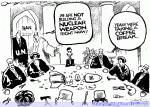Two years later, in 1999, the United States went a step further by alleging that the National Council of Resistance of Iran (NCRI), a political organization made up of several Iranian opposition groups that reject clerical rule, was a front for the MEK and designated it too as a terrorist group. Martin Indyk, then Assistant Secretary of State for Near East Affairs, indicated that the State Department added the National Council of Resistance (NCR) as an alias for the Mujahedin-e Khalq (MEK) because “The Iranian government had brought this to our attention. We looked into it and saw that there were good reasons for designating the NCR as an alias for the MEK.” The United Kingdom (UK) and European Union (EU) followed suit, pinning the MEK/PMOI (though not the NCRI) to their terror lists.
The evidence, however, demonstrates that the US military officers and contractor killings that formed the basis of the original designation were carried out by a secular hard-left splinter group, with no ties to MEK leadership; that there was no proof that the MEK played a role in the 1979 embassy takeover; and that the armed resistance carried out by the MEK from Iraq was directed at official regime targets, not innocent civilians, at a time that their relatives and sympathizers were being jailed, tortured and executed en masse.
Today, there is also good evidence that Iran lobbied hard to get the United States and other Western governments to designate the MEK as terrorists, even though the allegations were baseless. Only a day after the US added the MEK to its FTO list in October 1997, the Los Angeles Times reported: “One senior Clinton administration official said inclusion of the People’s Mojahedeen was intended as a ‘goodwill gesture’ to Tehran and its newly elected moderate president Mohammad Khatami.” Five years later, the same official told Newsweek: “[There] was White House interest in opening up a dialogue with the Iranian government. At the time, President Khatami had recently been elected and was seen as a moderate. Top administration officials saw cracking down on the [PMOI/MEK] – which the Iranians had made clear they saw as a menace, as one way to do so.”
Across the Atlantic, similar political considerations operated. In an interview with BBC Radio in 2006, then British Foreign Secretary Jack Straw admitted that the UK designation of the MEK in 2001 was specifically issued in response to demands made by the Iranian regime. That same year, classified documents, later unclassified by a UK court, revealed that senior foreign service officials were concerned about possible adverse foreign policy consequences if the terrorist designation was lifted since the Iranian regime prioritized “tough legal and political measures” against the organization. The EU too is now known to have bowed to pressure in designating the MEK in 2002.
Supporters of removing the terrorist designation took their case to courts. These efforts met with strong resistance, not only from spokespersons for Iran but also from representatives of a new Iran-tilting government in Iraq. By 2006, seven European courts had ruled that the group did not meet lawful criteria for terrorism. They also ruled that the terrorist designation should have been moot after 2001, when the group’s leadership ceased armed resistance to focus on a political and social campaign to bring about democratic change in Iran. In the United States, where the courts similarly ruled repeatedly in favor of the MEK, and as many as 200 members of Congress signed statements endorsing its cause, the process was stalled until America’s second highest court granted the writ of mandamus filed by the MEK, and ordered the Secretary of State to take action or it would delist the group. Secretary Hillary Clinton, having been provided no credible basis for re-listing by the intelligence community, revoked the designation in September 2012.
It is curious why anyone would seek to re-litigate this and other rulings by high courts in Washington and Europe that forced Mr. Benjamin, in his capacity as the Department of State Coordinator for Counterterrorism, to remove the MEK from the FTO list.
But context is king: Benjamin and Rogin’s old and discredited claims arrive in the midst of a fierce tug-of-war between President-Elect Trump’s advisors to identify a Secretary of State. The post is likely to have a direct influence on US Iran policy. The tenuous nature of the Joint Comprehensive Plan of Action and the possibility of new rounds of sanctions make Tehran understandably anxious.
Benjamin insinuates that Mr. Giuliani and other former officials under consideration for senior posts in the Trump Administration are acting as “shills” for a “terrorist organization.”
One wonders whether there isn’t an urgent need for Washington to undertake a thorough counterintelligence investigation of Iran’s influence campaign in the US.
Such an investigation might implicate prominent former US officials and journalists doing the bidding of Washington’s pro-Iran lobby.
Dr. Ivan Sascha Sheehan is director of the graduate programs in Negotiation and Conflict Management and Global Affairs and Human Security in the School of Public and International Affairs at the University of Baltimore.
View Original Article at:
http://townhall.com/columnists/ivansheehan/2016/11/30/has-the-iran-lobby-set-its-sights-on-the-trump-administration-n2252851










